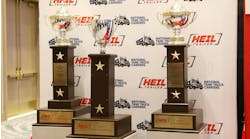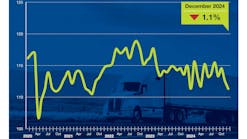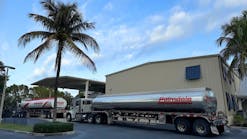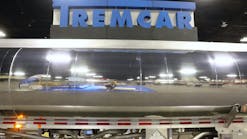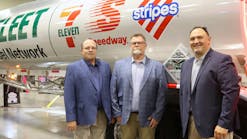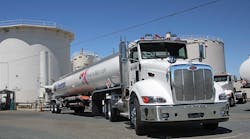Four Years ago, the Global Marketing Logistics team at Chevron Products Co made a commitment to build the best fuels distribution system in the world. While there is still work to do, they have made incredible progress.
One focal point of this effort is the Road Transport Safety Management (RTS) plan that sets out the company's expectations for operational excellence in all facets of Chevron fuel delivery system.
“We believe we are well on our way toward our goal of developing the best fuel distribution system in the world,” says George Wall, Chevron vice-president for global logistics. “The numbers show that our global distribution operations have improved every year for the past four years. We'll steadily ratchet up the process management, and we will continue to implement the technology and systems needed to be the best.
“We developed the RTS standard to set the bar for our worldwide distribution operations. It also helped us tie together our global fleet operations, which had grown significantly after we combined Chevron, Texaco, and Caltex into a single global organization. The standard gave us the ability to address what we felt was an unacceptable level of distribution incidents.
“We are making progress, but we want to constantly get closer to zero accidents and incidents. We want to have the most efficient and effective distribution operation in the petroleum industry by using best-in-class processes.”
Expanding program
Al Mosser, Chevron global equipment standards manager, adds that the next step is to apply the same unified global approach to Chevron's worldwide storage and terminaling system. “Transportation was just the beginning,” he says. “We want this type of management system to encompass our entire land logistics and distribution process.”
Entities covered by the Road Transport Safety Management plan serve the Chevron, Texaco, and Caltex brands. Fuels under the three brands are marketed in more than 70 countries around the world.
The worldwide fuels distribution operations are coordinated through Chevron's Global Marketing Logistics department, which is based in San Ramon, California.
“We've had a centralized dispatching system in the United States for many years based in Concord (California) using Aspen Tech and SAP applications,” Mosser says. “Regional dispatch centers for other parts of the distribution network are now being established in Capetown, South Africa, and Makati, Philippines.”
Distribution system
The Global Marketing Logistics department oversees a very large fuels distribution system. The department coordinates worldwide distribution of approximately 12 billion gallons of fuel products each year. Roughly a third of the total volume is handled by Chevron's proprietary fleet of 500-plus petroleum transports, 115 of which are in the United States. Approximately 100 contract carriers transport the overwhelming majority of fuels shipments. They range in size from hundreds of trucks to as few as 10.
“We significantly reduced the total number of contract carriers over the past couple of years,” says Ken Smith, Chevron Global Logistics Center of Focus general manager. “We look for transportation partners who can meet our high standards or are willing to make the needed changes to do so. They absolutely must embrace our Road Transport Safety management policy. That is a tough step for some of them, but we make it worth the effort.
“We start with a three-year contract, but our objective is to build a long-term relationship. We are there to help them if they make the commitment, and most say it is worth the effort. We want them with us indefinitely. By reducing our total number of contract fleets, we're able to give our carrier partners more business. That means more revenue for them to help cover the vehicle technology improvements that help make their operations safer and more productive. It is a win-win arrangement.”
The 10-point policy provides a comprehensive approach to managing road transport safety. “We make it clear to our contractors that this program applies to our own fleet just as it does to theirs,” Smith says.
Element one
Element one of the program defines fleet management responsibilities and accountability. Responsibilities for managers, supervisors, and drivers are clearly defined. Key elements of the mandatory safety program are laid out, including vehicle inspections, crash investigations, and emergency response.
Each carrier partner must implement an audit procedure to verify compliance with the various facets of the program. Monitoring occurs at all levels of the Chevron Global Marketing Logistics system. Chevron managers meet with carrier partners as often as monthly and not less than quarterly to review a range of operational factors, including on-board computer data. Annual reviews also are conducted.
These reviews play a big role in Chevron's “Global Carrier of the Year” program. The award recognizes demonstrated excellence in the implementation of the Road Transport Safety Management system. The 2007 winner was Transportes Barahona, a carrier based in Comayagua, Honduras.
Journey management
Element two focuses on the journey management process developed by Chevron. Every trip for every shipment is planned in advance to minimize risks involved. Emergency response planning also is part of the journey management process for each trip. Nothing is left to chance.
“No matter how often deliveries are made to a service station, a journey plan is printed and reviewed for each delivery,” says Sharon Seekatz, Road Transport Safety manager. “Plans are locally generated, and they outline all of the hazards likely to be encountered by the driver.
“Plan development involves drivers, driver instructors, driver supervisor, and safety specialists or driver trainers. We store the plans on computer and print them out with each dispatch. We update the plans anytime there are changes to the route or at the delivery site. We identify the safest routes and every possible risk at the delivery location.”
Driver selection and health are covered under Element three of the program. Selection criteria are aimed at ensuring that newly hired truck drivers will be capable of safely and effectively carrying out their duties without risk to their own health, and the health of their colleagues and the health of the general public.
“At Chevron, we have very high standards and only hire the most qualified candidates,” Seekatz says. “Often, the safest and most qualified drivers come from the carriers that haul product for us. Our own drivers provide some excellent recommendations. We look for demonstrated maturity and a strong work ethic.”
To be considered, an applicant must have at least some experience behind the wheel of a tank truck. Chevron conducts a criminal background check, a thorough review of the applicant's driving record, drug/alcohol screening, and fitness for duty examination. In the United States, an applicant must have a Transportation Worker Identification Card (TWIC) and a current commercial driver license with tank and hazardous materials endorsements.
Driver training
Driver training falls under Element four. This part of the plan provides detailed guidance on Chevron's expectations for driver training, its frequency, and expected outcomes. The program calls for regular in-cab performance assessments and coaching by a driver trainer.
The new driver training program runs a minimum of 120 hours and is intended to build new safe driving habits, according to Sara Porter, manager of Regional Fleet Operations-North America. While the primary focus of the training program is on Chevron's proprietary fleet, the company also asks contract carriers to use a similar program.
Chevron's driver training program was custom-designed and starts with two days of classroom instruction. Each newly hired driver receives a copy of Chevron's truck driver manual on the first day of training. Customized for the region in which the driver will operate, the manual provides a wide range of useful material, including equipment background information and equipment inspection checklists.
Topics covered during the classroom instruction include Chevron's behavior-based safety system, various Department of Transportation regulations, and ergonomics. New drivers also complete the computer-based Smith System program on safe driving.
“During hands-on instruction, we make sure drivers know how to perform complete pre-trip and post-trip vehicle inspections,” Porter says. “We want to ensure our trucks will perform safely and reliably and won't have to be towed back to the terminal. We also show them how to properly operate all product handling hardware on the trucks and at delivery sites.”
Specific training
Newly hired Chevron drivers, as well as other carrier's drivers, must complete training on terminal-specific operating and safety procedures and practices. Training is provided by terminal personnel and takes about four hours. Drivers must demonstrate an understanding of the loading rack procedures at the conclusion of the training.
The initial orientation is just the beginning of a training process that continues throughout the time a driver works for Chevron. Annual refresher training is mandated. Refresher training covers defensive and safe driving, loading and unloading procedures, hazardous materials handlng, and general safety.
Most of the training is handled by driver instructors, who are working drivers who have been identified as having the skills required to be effective coaches. Chevron requires at least one instructor be available for each of the loading terminals where it has trucks. In addition, fulltime regional driver training specialists conduct 30-, 90-, and 180-day check rides with new hires. Check rides also are scheduled when there is an indication of risky driving behavior.
Chevron has four driver training specialists in North America and two in Latin America. Six driver training specialists are based in South Africa.
Driver monitoring
Driver performance is monitored daily in the Chevron road transport system, and this is Element five in the Road Transport Safety program. Chevron's Loss Prevention System behavior-based safety management is used throughout the worldwide fuels trucking operation. All fleet managers and drivers participate in the program, which includes loss prevention observations and loss and near-loss investigations. On-board computers also play a big role in the performance monitoring effort.
“We began installing the Cadec Mobius TTS system three years ago, and we have specified Cadec equipment in our US trucks for more than 15 years,” says Jim Fleming, fleet standards specialist in Chevron's Global Marketing Logistics unit. “The Mobius TTS system provides tracking and communication with GPS and cell phone technology.”
Fleming adds that Chevron requires Cadec (or comparable) systems in all of its trucks and vehicles operated by contract carriers. “We want to be able to track and reward desirable driver performance, which is the vast majority of our observed activities, in addition to dealing with the occasional undesirable behaviors that are risky or dangerous,” he says.
In addition to using the Cadec system, Chevron partners with Digicore in Africa and Siemens VDO hardware in Latin America.
Fleming says the crucial first step with contract carriers was to convince them to install the onboard systems in their trucks. Next Chevron Global Marketing Logistics managers had to show them how to use the information to improve driver performance and safety.
Chevron uses a Green/Yellow/Red (GYR) program — co-developed by Chevron, Cadec, and Kenan Advantage Group (one of Chevron's strategic carriers) — to analyze sudden decelerations, speeding events, overreving the engine, and roll stability system actuations. “We've seen a lot of progress since we started using this tool about two years ago,” Fleming says. “At our Avon (California) terminal for instance, drivers average 98%-99% green, which means they are performing like we want. The national average for Chevron in the United States is 85% green, up substantially from a 15% average when we launched the program.”
Going beyond the on-board computer, Fleming is working with North America colleagues to pilot an on-board camera system in their Los Angeles, California, fleet. The camera is proving useful in driver coaching and is valuable in incident investigations. Information and experience gained from the pilot project will support development of a global standard for the camera system within Chevron's distribution network.
Improved driving affects more than safety. It has a direct impact on the bottom line with regard to fleet operating costs. “When driving improves, we see better performance out of the vehicle and less wear and tear,” Fleming says. “Some locations are recording a 15% to 18% fuel economy improvement. The GYR program can really pay dividends.”
Fleets specs
Looking beyond the on-board monitoring requirement, the Global Marketing Logistics unit developed a comprehensive catalog of vehicle specifications both for the Chevron proprietary truck fleet and contract carriers. Chevron's Global Truck Standard is Element six in the Road Transport safety Management Plan.
The standard offers maximum flexibility to enable Chevron and its contract carriers to meet various design standards and regulations in different parts of the world, while ensuring that critical elements are met. The oil company does not stipulate vehicle or component brand names in most cases. It is primarily a performance standard.
Conventional or cabover trucks are acceptable. Daycabs are preferred, but sleeper cabs are allowed in special circumstances. Trucks must be powered by a diesel engine with eight to 10 horsepower per 900 kilograms (1,980 pounds) of gross combined vehicle weight. Chevron has encouraged a shift to tractor-trailer combinations, but various straight truck configurations are used by the company and its contractors.
“Tank trucks are still a big part of our distribution operation, especially overseas,” Fleming says. “Our goal is to expand the use of tractors and semi-trailers to optimize productivity. However, infrastructure limitations affect what we do in some countries. We have some truck-and-trailer combinations in the United States, but the fleet here is predominantly tractor and semi-trailer.”
In the United States, Chevron has standardized on Peterbilt 384 daycab conventionals with Caterpillar C13 engines rated at 410 horsepower for tractors. Trucks used in super tanker truck-and-trailer configuration are powered by a 430-hp Cat engine. Tractors get a 10-speed Fuller Roadranger, and super tankers have a 13-speed gear box.
Truck safety features required by Chevron include a battery isolation switch, speed limiting device, wheel chocks, and plenty of mirrors. The oil company also requires roll stability systems on all new vehicles.
Chevron is ordering Bendix roll stability systems on company-owned new tractors and trailers in North America. “We were one of the first companies to order roll stability on the Peterbilt 385 daycab tractor,” Mosser says. “In fact, Peterbilt and Bendix used our truck to set the parameters for the system. We're pushing roll stability in all of the areas where Chevron operates worldwide. We want roll stability used wherever it is available, and we're not going to back off on this requirement.”
Heil Trailer International is the primary tank trailer supplier for the Chevron fleet. Trailers used in the United States are constructed to DOT406 code and have four compartments with a total capacity of 9300 gallons.
Tank hardware on US trailers includes Dixon Bayco elbows and API outlets, Civacon vapor recovery, Jikoh sight glasses, EBW brake interlock, and Scully overfill protection. The newest trailers have Hendrickson's Intraax air suspension, Meritor tire inflation, Michelin X One single tires, and Alcoa aluminum disc wheels.
Cargo tanks should be constructed of aluminum (alloy 5454), and the tank shape should be elliptical. Every effort should be made to achieve a low center of gravity, and the tank should be sloped to enable drain-dry unloading on a 5% slope. Chevron typically uses cargo tank compartment of different capacities, and each compartment should have a spray deflector mounted above the inlet/outlet.
All cargo tank vehicles are to be configured for bottom loading even if top loading is the current practice. Brake interlock devices are required. Discharge outlets should have Plexiglas sight glasses. Product security systems are to be installed wherever required by Chevron.
Chevron requires fall protection on any cargo tank vehicle that routinely has drivers or other personnel climbing on top. Acceptable systems include a dual collapsible rail, Standfast TRAM unit, and dual cable/harness arrangement.
Chevron has begun to call for air suspensions on all non-steer axles. The company also wants automatic tire inflation systems on tank trailers. Aluminum wheels should be standard.
Trucks and tractors used in Chevron distribution operations must be less than 10 years old. Cargo tanks can remain in service longer, subject to government and Chevron limits. Vehicles should be maintained according to manufacturer recommendations on a pre-determined schedule. All maintenance must be documented.
Operating requirements
Fleet operating requirements are covered in Element seven. Every effort is made to maximize fleet productivity without compromising safety. In the US fleet, slip-seating is common, and most Chevron locations run 3.5 drivers per truck. Ideally, the truck is on the road 22 hours a day, seven days a week.
Driver fatigue gets plenty of attention. Chevron sets a corporate driving limit of 12 hours in a 24-hour period for areas of the world with few driving regulations. Drivers can be on duty no more than 14 hours in a 24-hour period, and they can drive no more than 72 hours in a seven-day period. Chevron follows Department of Transportation hours of service requirements in the United States and is rolling out a comprehensive new fatigue management program to educate drivers and their families on the need for drivers to get adequate rest.
Fleet performance is monitored throughout the Chevron Global Marketing Logistics operation. At a minimum, Element eight calls for Chevron fleet managers and contract carriers to track motor vehicle crashes, days away from work due to injuries, total recordable injuries, product spills, and product mixes/contaminations. A Road Transport System compliance assessment is conducted annually on each carrier.
Contract carrier management is addressed in Element nine. Chevron officials meet quarterly with carriers, and they provide a carrier performance scorecard. Every effort is made to build a solid long-term relationship with each carrier partner. Chevron officials encourage carrier executives to take a proactive approach in building better operations. They also encourage the sharing of best practices.
Chevron Road Transport Safety managers inspect contract carrier equipment before it hauls the first load. Random spot equipment inspections also are conducted at Chevron terminals.
Going beyond the carrier partners, Chevron works with the communities where it has fuels distribution operations to improve the driving environment and road safety in general. This is Element ten, and the final step, in the Road Transport Safety Management Plan.
Chevron's Global Marketing Logistics managers continue to refine the elements in the Road Transport Safety Plan. They won't be satisfied until they have the best fuels distribution program in the world. ♦
